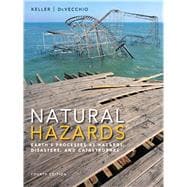Natural Hazards: Earth Processes as Hazards, Disasters and Catastrophes , Fourth Edition, is an introductory-level survey intended for university and college courses that are concerned with earth processes that have direct, and often sudden and violent, impacts on human society. The text integrates principles of geology, hydrology, meteorology, climatology, oceanography, soil science, ecology and solar system astronomy. The book is designed for a course in natural hazards for non-science majors, and a primary goal of the text is to assist instructors in guiding students who may have little background in science to understand physical earth processes as natural hazards and their consequences to society.
Natural Hazards uses historical to recent examples of hazards and disasters to explore how and why they happen and what we can do to limit their effects. The text's up-to-date coverage of recent disasters brings a fresh perspective to the material.
The Fourth Edition continues our new active learning approach that includes reinforcement of learning objective with a fully updated visual program and pedagogical tools that highlight fundamental concepts of the text. This program will provide an interactive and engaging learning experience for your students. Here's how:
Provide a balanced approach to the study of natural hazards: Focus on the basic earth science of hazards as well as roles of human processes and effects on our planet in a broader, more balanced approach to the study of natural hazards.
Enhance understanding and comprehension of natural hazards: Newly revised stories and case studies give students a behind the scenes glimpse into how hazards are evaluated from a scientific and human perspective; the stories of real people who survive natural hazards, and the lives and research of professionals who have contributed significantly to the research of hazardous events.¿
Strong pedagogical tools reinforce the text's core features: Chapter structure and design organizes the material into three major sections to help students learn, digest, and review learning objectives.








